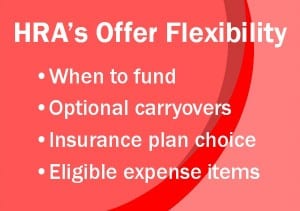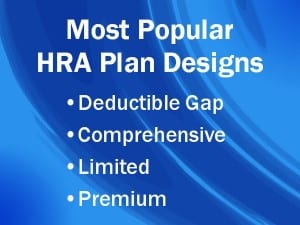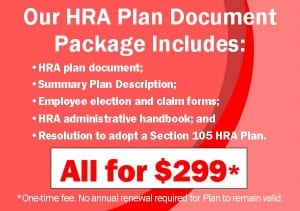Health Reimbursement Arrangements, known as HRA Plans, have been used for years by insurance agents and benefit plan designers. HRA Plans can be used to reimburse allowed medical, dental, vision, and specific insurance premium expenses to employees tax-free.
HRA’s and FSA’s
HRA’s are like health Flexible Spending Accounts (FSA’s) with subtle differences:
HRA’s can be designed to pay last, after the Health FSA. Normally the health FSA must be the payer of last resort in any employer-sponsored plan. However, the IRS has authorized employers to design HRA’s to require the health FSA to pay first, reducing health FSA forfeitures under the use-it-or-lose-it rule.
Who Can Establish an HRA Plan?
Sole proprietors, partnerships, regular corporations, S corporations, limited liability companies (LLCs), professional corporations, and 501(c)3 non-profits are all allowed to establish an HRA Plan for the benefit of their employees.
Who Can Participate in the HRA?
However, the owners of said entities cannot personally participate in an HRA. This includes sole proprietors, partnerships, and LLCs, although special exceptions are made for owners of C corporations.
Benefits of a Health Reimbursement Arrangement
An HRA Plan has several advantages over the Flexible Spending Account (FSA) that is a part of most Section 125 benefit plans. Here are just a few of those perks:
 1) Control. The HRA allows the employer to retain control of funds. This means deciding the types of expenses that will be reimbursed and whether HRA funds will carry over from year to year.
1) Control. The HRA allows the employer to retain control of funds. This means deciding the types of expenses that will be reimbursed and whether HRA funds will carry over from year to year.
2) Financial Flexibility. In contrast to an FSA, the Health Reimbursement Arrangement does not require pre-funding. Employers reimburse plan members for eligible expenses as they occur. As a result, the company’s assets are freed up for other uses.
3) Tax Savings. Reimbursements made through an HRA are tax-deductible for the employer and tax-exempt for employees. This means everyone enjoys a tax advantage and lower overall costs when an employer selects an HRA.
4) Choice. With no restrictions on the type of health plan that can be paired with an Health Reimbursement Arrangement, employers are free to choose the perfect plan for their employees. Plus, employees get to decide where and when to spend the HRA funds and, depending on the HRA design options elected by the employer, employees may:
- Request reimbursement for medical expenses at the time the services are rendered;
- Accumulate expenses for reimbursement in the future; or,
- Save the funds for retiree health benefits.
HRA Carryover Provisions
HRA Plans with a carryover feature can only be offered on a tax-favored basis if the following conditions are met:
-
Is funded solely with employer contributions; and,
-
Only reimburses substantiated medical care expenses incurred by employees and their spouses and dependents.
It is also important to know that:
- While no employee dollars may fund the HRA Plan, employees can pay a portion of the premium for an employer-sponsored high-deductible group health insurance plan offered with the HRA.
- Unused portions of an HRA account may be carried over but cannot be cashed out (though terminated employees can spend down their HRA balances after they terminate).
Popular HRA Plan Types
The built-in flexibility of the Health Reimbursement Arrangement means an employer has a lot of important decisions to make in plan design. After years of working with clients, Core Documents has found these four to be the most popular HRA Plan types:
 1) Deductible Gap HRA Plan
1) Deductible Gap HRA Plan
The Deductible Gap HRA Plan is designed to be combined with a high-deductible health insurance plan and will only pay for items covered by the group insurance policy that it goes with.
For example, the employer buys a high-deductible insurance plan – in this example, a $2500 annual deductible at a considerable savings – but the employees are used to paying only a $500 annual deductible.
This is where the Deductible Gap HRA Plan comes in, as it allows employees to continue paying only $500 in annual deductibles while likewise increasing the amount of deductible expenses that are covered for the employer.
In the example used above, an employer’s deductible expense coverage would range anywhere from $501-$2000 under the Deductible Gap HRA Plan, while still holding the employee’s rate at $500.
Keep in mind, however, that only employees who actually experienced a deductible in excess of their normal $500 would receive HRA proceeds. With this plan, both the employer and employee benefit from reduced insurance costs. See HRA Group Premium Savings Calculator.
2) Comprehensive HRA Plan
The Comprehensive HRA Plan is a viable option if combined with an employer-sponsored group health plan (including employees participating in a spouse group health plan). It can be used to reimburse most 213(d) medically-necessary out-of-pocket expenses, including excepted benefit insurance premium expenses.
Through this HRA plan design, employers may provide employees with a set amount of dollars every year or every month to spend on allowed expenses. Unused HRA account balances can be rolled over from one Plan Year to the next, so funds can accumulate over the lifespan of the plan.
Employees who are not enrolled in an eligible employer-sponsored group health plan can still use the Comprehensive HRA Plan for dental, vision, and excepted benefit insurance premium expenses.
3) Limited HRA Plan
A Limited HRA Plan design is very versatile as design options are unlimited.
 Employers who find ways to reduce premium by adding extra deductibles or co-payments can establish an HRA to pay those expenses (if they occur), and by doing so save money on their group insurance plan.
Employers who find ways to reduce premium by adding extra deductibles or co-payments can establish an HRA to pay those expenses (if they occur), and by doing so save money on their group insurance plan.
This plan essentially allows employers to cut premiums and insure the difference themselves via a Limited HRA Plan. Limited HRA Plans can also be restricted to just one type of medical expense, like prescription drugs, dental, vision, or other types of insurance.
4) Premium Reimbursement Arrangement (PRA) Plans
The PRA Plan allows employers to reimburse insurance premiums, including dental insurance, vision insurance, ancillary insurance, certain cancer and indemnity plans, and long-term care insurance – essentially most group policies and excepted benefits. See: Excepted Benefits under PPACA (aka ACA, Health Care Reform, ObamaCare).
Frequently Asked Questions on HRA Plans
- Is an HRA subject to COBRA rules? An HRA Plan is generally subject to COBRA continuation coverage requirements unless the small employer exemption applies.
- Do non-discrimination rules apply? Yes. HRAs can not discriminate in favor of highly compensated employees.
- Can changes be made before the end of an HRA Plan year? Yes. The 12-month period of coverage and prohibition of mid-year changes does not apply to an HRA Plan.
- Is a HRA Trust Account Required? No, not by the Code, but possibly by ERISA (no trust is required if HRA reimbursements are made directly out of the general assets of the employer.
- Are HRA Account Earnings Taxable? This is not applicable if reimbursements are made directly out of the general assets of the employer. Also, if the HRA is funded by a Voluntary Employee Beneficiary Association (VEBA) trust account, earnings are generally not taxable.
- Does Form 5500 reporting apply? Employer HRA groups that cover more than 100 participants must file an IRS Form 5500 within seven months of the end of the plan year.
- Is an HRA Plan Document Required? Yes. The Code requires that the HRA plan be in writing and that every participant receives a Summary Plan Description, (SPD).
HRA Plan Document Package Just $199
 Core Documents is glad to offer a professional, personalized, and cost-effective HRA Plan Document Package. Our package includes the following:
Core Documents is glad to offer a professional, personalized, and cost-effective HRA Plan Document Package. Our package includes the following:
1) HRA Plan Document. Plan Documents are personally prepared and emailed to each client. Upon arrival, the HRA Plan Document should be accepted and signed by the owner or officer of the company. The Plan Document should also be kept on file for review by employees, accountants, the IRS, and other important persons.
- The Basic PDF version is just $199.
- A printed Deluxe version with 3-ring binder is just $50 more (ships via Priority Mail).
2) HRA Summary Plan Description (SPD). The Summary Plan Description is required for each employee. It explains the Plan Purpose, Eligibility, Enrollment, and other important information in accessible language. The SPD also includes all information required by the IRS, DOL, FMLA, and COBRA regarding Plan Year start and end dates, legal service agents, and federal I.D. numbers.
3) HRA Election and Claim Form. This document is personalized for the business and will include the Election and Claim Form that is necessary to submit bills for reimbursement by the company.
4) HRA Administrative Handbook. This invaluable handbook includes sections on Administration, Nondiscrimination Testing, and Reporting and Disclosure. The client will be provided with instructions regarding plan setup, maintenance procedures, and other important steps.
5) Resolution to Adopt a Section 105 Plan. This document includes the Minutes of the Meeting to Adopt the Section 105 Plan as an employee benefit and reference.
Ready to Order?
The HRA Plan Documents Package from Core Documents has all you need to establish your Health Reimbursement Arrangement for a one-time fee of $199 with no required renewals or annual subscriptions. You can order the package online or by fax. Just click on a button for the form that best suits you: